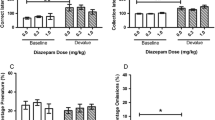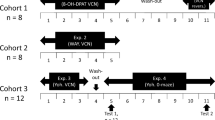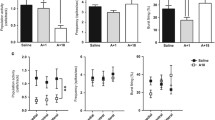Abstract
The present study examined the effect of acute and repeated administration of electroconvulsive shock (ECS) on behaviours induced by various dopamine agonists in rats. Components of behavioural arousal induced by the dopamine D-1 agonist SKF 38393, the dopamine D-2 agonist RU 24213 and the mixed D-1/D-2 agonist apomorphine were assessed using a behavioural check-list method. Also, the overall behavioural syndrome produced by these drugs was measured using rating scales. Rats receiving repeated (5 times over 10 days) but not a single ECS showed enhanced grooming and sniffing in response to SKF 38393 (7.5 mg/kg) when compared to controls. Repetitive sniffing induced by apomorphine (0.5 mg/kg) was also enhanced by repeated ECS. Neither repeated nor a single ECS significantly changed behaviours induced by RU 24213 (0.75 mg/kg), although a downward trend was evident. The behaviour rating scale measurements also demonstrated that repeated administration to ECS increased behavioural responsiveness to SKF 38393 and apomorphine but not RU 24213. These results suggest that the increase of dopamine-mediated behaviour in rats seen after chronic ECS relates to an increase in central dopamine D-1 receptor function.
Similar content being viewed by others
References
Atre-Vaidya N, Jampala VC (1988) Electroconvulsive therapy in Parkinsonism with affective disorder. Br J Pharmacol 152:55–58
Balldin J, Eden S, Granerus AK, Modigh K, Svanborg A, Walinder J, Wallin L (1980) Electroconvulsive therapy in Parkinson's syndrome with “on-off” phenomenon. J Neural Transm 47:11–21
Bhavsar VH, Dhumal VR, Kelkar VV (1981) The effect of some anti-epilepsy drugs on enhancement of the monoamine-mediated behavioural responses following the administration of electroconvulsive shocks to rats. Eur J Pharmacol 74:243–247
Breese GR, Duncan GE, Napier TC, Bandy SC, Iorio LC, Mueller RA (1987) 6-Hydroxydopamine treatments enhance behavioural responses to intracerebral microinjection of D-1 and D-2 dopamine agonists into nucleus accumbens and striatum without changing dopamine antagonist binding. J Pharmacol Exp Ther 240:167–176
Christensen AV, Arnt J, Hyttel J, Larsen J-J, Svendsen O (1984) Pharmacological effects of a specific dopamine D-1 antagonist SCH 23390 in comparison with neuroleptics. Life Sci 34:1529–1540
Clark D, White FJ (1987) Review: D-1 dopamine receptor the search for a function: a critical evaluation of the D-1/D-2 dopamine receptor classification and its functional implications. Synapse 1:347–388
Costain DW, Cowen PJ, Gelder MG, Grahame-Smith DG (1982) Electroconvulsive therapy and the brain: evidence for increased dopamine-mediated responses. Lancet II:360–362
Deakin JFW, Owen F, Cross AJ, Dashwood MJ (1981) Studies on possible mechanisms of action of electroconvulsive therapy: effects of repeated electrically induced seizures on rat brain receptors for monoamines and other neurotransmitters. Psychopharmacology 73:345–349
Evans JPM, Grahame-Smith DG, Green AR, Tordoff AFC (1976) Electroconvulsive shock increases the behavioural response of rats to brain 5-hydroxytryptamine accumulation and central nervous system stimulant drugs. Br J Pharmacol 56:193–199
Green AR, Nutt DJ (1987) Psychopharmacology of repeated seizures: possible relevance to the mechanism of action of electroconvulsive therapy. In: Iversen LL, Iversen SD, Snyder SH (eds) Handbook of psychopharmacology, vol 19. Plenum Press, New York, pp 375–419
Green AR, Heal DJ, Grahame-Smith DG (1977) Further observations on the effect of repeated electroconvulsive shock on the behavioural responses of rats produced by increases in the functional activity of brain 5-hydroxytryptamine and dopamine. Psychopharmacology 52:195–200
Green AR, Sant K, Bowdler JM, Cowen PJ (1982) Further evidence for a relationship between changes in GABA concentration in rat brain and enhanced monoamine-mediated behaviours following repeated electroconvulsive shock. Neuropharmacology 21:981–984
Green AR, Heal DJ, Johnson P, Laurence BE, Nimgaonkar VL (1983) Antidepressant treatments: effects in rodents on dose-response curves of 5-hydroxytryptamine and dopamine-mediated behaviours and 5-HT2 receptor function in frontal cortex. Br J Pharmacol 80:377–385
Heal DJ, Green AR (1978) Repeated electroconvulsive shock increases the behavioural responses of rats to injection of both dopamine and dibutyryl cyclic AMP into the nucleus accumbens. Neuropharmacology 17:1085–1087
Hemmings HC, Walaas SI, Ouimet CC, Greengard P (1987) Dopamine receptors: regulation of protein phosphorylation. In: Creese I, Fraser CM (eds) Dopamine receptors, receptor biochemistry and methodology, vol 8. Liss, New York, pp 115–151
Iorio LC, Barnett A, Leitz FH, Houser VP, Korduba CA (1983) SCH 23390, a potential benzazepine antipsychotic with unique interactions on dopaminergic systems. J Pharmacol Exp Ther 226:462–468
Kebabian JW, Calne DB (1979) Multiple receptors for dopamine. Nature 277:93–96
Kelly PH, Seviour PW, Iversen SD (1975) Amphetamine and apomorphine responses in the rat following 6-OHDA lesions of the nucleus accumbens septi and corpus striatum. Brain Res 94:507–522
Kingston J, Sharp T, Grahame-Smith DG (1988) Repeated ECS enhances dopamine D-1 but not D-2 agonist induced behavioural responses in rats. Br J Pharmacol 95:372P
Klimek V, Nielsen M (1987) Chronic treatment with antidepressants decreases the number of [3H]-SCH 23390 binding sites in the rat striatum and limbic system. Eur J Pharmacol 139:163–169
Martin KF, Needham PL, Atkinson J, Cowen A, Heal DJ, Buckett WR (1988) Rat striatal and mesolimbic D-1 receptor binding is not altered by antidepressant treatments including ECS and sibutramine HCl. Br J Pharmacol 95:896P
Mashurano M, Waddington JL (1986) Stereotyped behaviour in response to the selective D-2 agonist RU 24213 is enhanced by pretreatment with the selective D-1 agonist SKF 38393. Neuropharmacology 25:947–949
Molloy AG, Waddington JL (1984) Dopaminergic behaviour stereospecifically promoted by the D-1 agonist R-SKF 38393 and selectivity blocked by the D-1 antagonist SCH 23390. Psychopharmacology 82:409–410
Molloy AG, Waddington JL (1987) Assessment of grooming and other behavioural responses to the D-1 dopamine receptor agonist SKF 38393 and its R- and S-enantiomers in the intact adult rat. Psychopharmacology 92:164–168
Modigh K (1975) Electroconvulsive shock and postsynaptic catecholamine effects: increased psychomotor stimulant action of apomorphine and clonidine in reserpine pretreated mice by repeated ECS. J Neural Transm 36:19–32
Pugh MT, O'Boyle KM, Molloy AG, Waddington JL (1985) Effects of the putative D-1 antagonist SCH 23390 on stereotyped behaviour induced by the D-2 agonist RU 24213. Psychopharmacology 87:308–312
Stoof JC, Kebabian JW (1984) Two dopamine receptors: biochemistry, physiology and pharmacology. Life Sci 3:2281–2296
Author information
Authors and Affiliations
Rights and permissions
About this article
Cite this article
Sharp, T., Kingston, J. & Grahame-Smith, D.G. Repeated ECS enhances dopamine D-1 but not D-2 agonist-induced behavioural responses in rats. Psychopharmacology 100, 110–114 (1990). https://doi.org/10.1007/BF02245799
Received:
Revised:
Issue Date:
DOI: https://doi.org/10.1007/BF02245799




